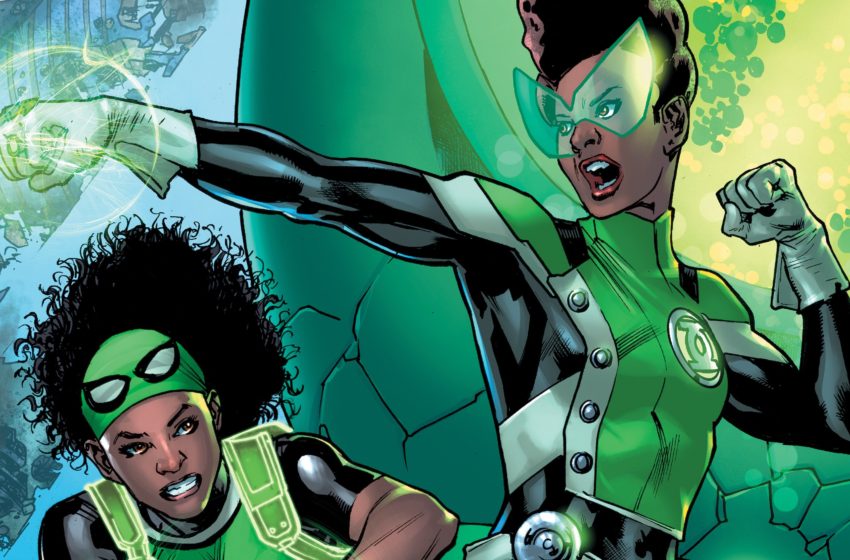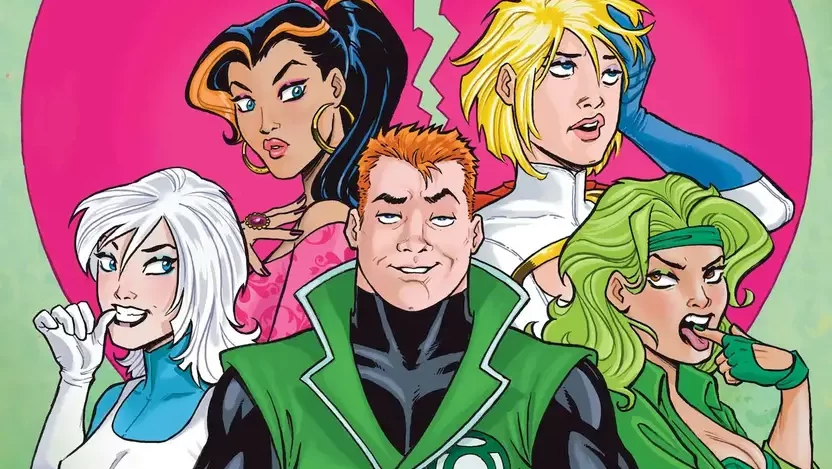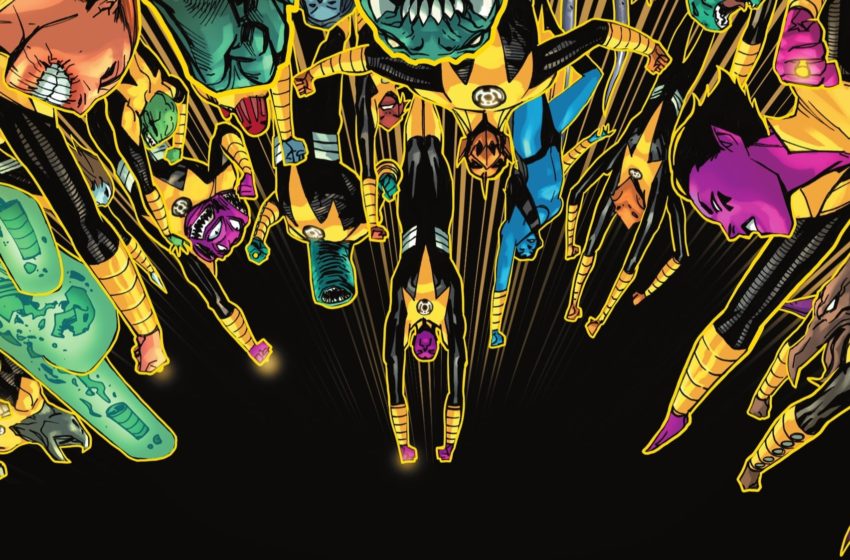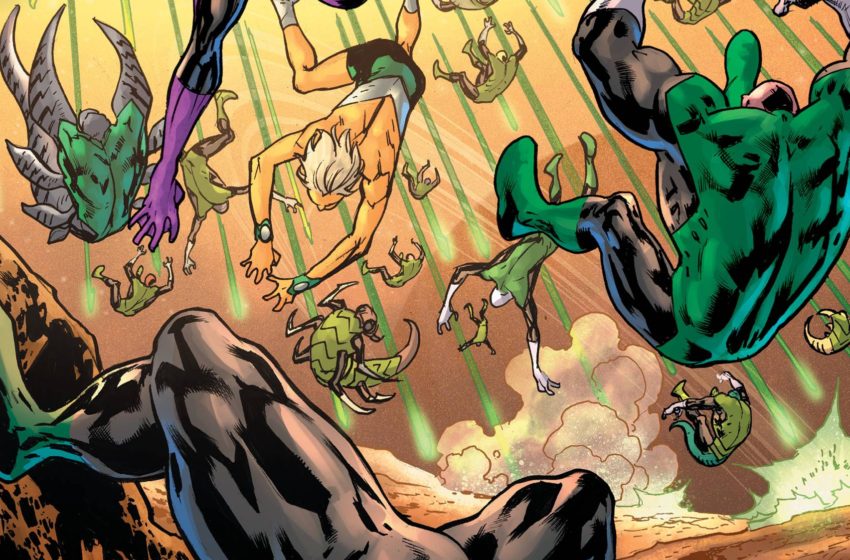The Central Battery has been destroyed – and most of Oa along with it. In the aftermath of this destruction, many Green Lanterns are left powerless, including John Stewart and the numerous Lanterns now stranded in the Dark Sector. In the meantime, new recruit Jo Mullein has arrived on Oa, and as one of the few Lanterns with a working ring, now has the weight of an entire Corps on her shoulders. Green Lantern #3 is written by Geoffrey Thorne,with art by Tom Raney and Marco Santucci, colors by Michael Atiyeh, and lettering by Rob Leigh.
Armaan Babu: This month, Green Lantern splits its storytelling focus right down the middle, so it is with both joy and worry that you’ll like him more than me that I welcome Jude Jones to split coverage of this series as well. Jude’s following Jo Mullein in from his excellent coverage of Far Sector, and he arrives just in time for what feels a lot like a jumping on point, which is bizarre for a series so early in its run.
Jude Jones: Armaan! It’s a pleasure and an honor to be here, and thank you for the kind words. And yes, bizarre is the right word for a lot of things about this run, particularly this issue. The entire status quo of the GL Corps essentially changed overnight, and repercussions are coming quick, fast, and in a hurry.
Before we delve too deeply into things, I think it’s prudent that I give two quick bits of background disclosures that will invariably shape how I look at things. First, I’m highly critical and sensitive to the look and feel of Black characters. Our people have too often been defined by stereotypical mannerisms, a lack of agency, and anachronistic design. I will pound the proverbial drum until those characterizations, our characterization, better reflect reality (yes, even in a work of fantasy). Second, I’m deeply, deeply skeptical of policing in general and police persons in particular. I’m not a fan in most capacities. Defund them. The GL Corps are police: a group of enforcers under the employ of an arrogant over class that impose their will on other worlds, often without the consent of those they protect. And while their purpose *kinda* changed after our last issue, old habits are hard to break. But we can get into that later.
Armaan: I’m looking forward to the perspective you bring to this book, Jude, though I do wish there was a better issue for you to get started with. After the dense storytelling we’ve had in the past two issues, the comic’s pacing changes here in a way I found disorienting. While the comic has juggled two artists and two narratives so far, I’m not sure how much I enjoy the even split. Let’s dive in.
Jude: Slight spoiler: I didn’t enjoy the split. But yes, let’s dive in.
Dream Disorientation in the Dark Sector

Armaan: Considering they were travelling in a ring-powered ship, one of the big questions is what happened to the thousand-and-one Lanterns assigned to the Dark Sector. John Stewart just about manages to survive, but his dreams are being remixed by a psychic trying to gather information from John without letting him know he was there. This psychic interrogation is certainly a unique way to catch us up on what’s happened – how well did this opening work for you?
Jude: So many more questions than answers for me here. First things first: the expository mechanism used to extract information – John having someone enter his mind, without his permission, playing with his emotions and searching his memories – is highly, highly problematic. I get why this was done: alien race, no working rings, the need to establish the background story and explain ring-less interspecies communication (as she entered his mind she also apparently taught him names and languages – very Krakoa-ish). But, for me, the why doesn’t absolve the what. And even if I take our extractor, the orange-hued Saqari, at her benevolent word (and if I’ve learned nothing in comics, I’ve learned that people who play with minds are almost never to be trusted), the optics of forcing yourself upon someone without consent, even for a greater good, will never sit right with me.
Ergo, again, why I don’t like cops in the first place.
That aside, the story flowed just fine. Not bad, not exceptional, but just fine. Our Lanterns broke through a barrier, established a beachhead base, spread out and summarily got wiped out as their rings (and almost everyone else with a standard Green Lantern ring) lost power as Oa was attacked. Does it seem strange, convenient and maybe a bit lazy that the alien race John was saved by seemed culturally American human, overalls and all? Yep. Am I surprised? Nope.
Armaan: It does seem like a waste of good Dark Sector to not introduce characters more alien in design, especially for a sector of space that’s been a mystery to the rest of the universe for so long. I also had a problem with Saqari’s introduction – at least, the moment I found out that she was not, in fact, meant to be a villain.
It’s not just that she invades John’s mind without his consent – it’s how deep she went. How much she manipulated his memories to get answers out of him. The way she played to his fantasies – the uncomfortable way she brought up both of his former loves. This is far from the best way to introduce a character you’re meant to be sympathetic towards. (Jude: Amen!)
Saqari tells John he’s on Sergilon, and introduces her child, Ilo. With no power in his ring and no real means of space travel on Sergilon, he makes his home with Saqari and Ilo – days, weeks, even months pass, and a few things Saqari mentions seem to imply that there’s some sort of time dilation effect happening in the Dark Sector. Months inside of it may only count for moments on the outside.
Aside from learning to fly on blue discs and stitching himself a physical Green Lantern uniform, John doesn’t really appear to be doing much with his time on Sergilon – until the day Quinari slavers arrive, and those old habits you mentioned kick in.
Jude: The time dilation really bothered me. I can’t imagine John spending months seemingly oblivious to his oath. I can’t imagine spending months wearing the same shirt (Wait, actually, post COVID, yes I can). This bothered me more than anything else, really – his lax nature on the planet seemed out of character, and gave credence to my theory that Saqari did a little more than dive (way too deeply) into his memory. Again, I’m not so sure she’s not a villain. But we will see.
Armaan: I’d be more bothered by the mischaracterization of John if it didn’t feel like the time jump was just a way to start bridging the gap between the present and the timeline we saw in Future State. War with the Quinari was a big part of John’s story in those issues, and it feels like the main purpose of these lost days is so that we can see G’nort, Salaak and what other surviving Lanterns they are all in radically different situations when we see them next. While that’s fine enough on its own, leaving John to do nothing but twiddle his thumbs for almost half a year is a very lazy choice.
A Word on Art

Jude: I need to be blunt here: the art, specifically the first half/two thirds by Tom Raney, just does not look good at all. I am not a fan. The facial expressions, the mannerisms, the lack of consistency or symmetry in faces – this might be someone’s cup of tea as art is subjective, but it’s not mine. It looks better suited for horror at best; it looks amateurish at worst. John is drawn like a different man from panel to panel, yet he maintains that horrid bowl cut that’s supposed to be some kind of fade. Part of getting Black characters right is getting the hair right. Our hair has always been political, and it’s presentation is always purposeful. Normally an atrocious haircut would raise my ire, but as everyone and everything else looks warped, I’m not sure if it’s even worth expending energy on.
Marco Santucci, at least, maintains better consistency between characters in his section. The lines feel more focused, more purposeful, if not particularly pretty. I’m not a fan of splitting up art duties unless the theme of the work benefits from it: nothing thematically benefits here. It’s just…fine.
But! We have to talk about Jo, because her appearance here is not fine.
In Far Sector, Jo’s body eschews the normal tall slender female physique. Jamal Campbell drew her with thicker thighs, maybe a fuller waist, and a less exaggerated cup size. I don’t want to say she’s drawn like a real woman, because women exist in all shapes and sizes and deserve respect regardless. But I will say she’s drawn in a way that’s more relatable to more of the women, particularly the Black women I know. I loved that. I know it was intentional. I appreciated that tacit bit of representation.
Yet here, her body looks the same as every other heroine: invisible waist, pronounced yet slender hips, prominent bust. That’s disappointing, if not frustrating, if not just plain wrong. You wouldn’t draw Nightcrawler without a tail, or make Superman suddenly blond. The details matter, and to miss this detail about her person, her image, is really a sad miss. It takes away from much of what made her character revolutionary. It makes her more rote. More normal. More replaceable.
Which, in turn, just makes me more frustrated.
Armaan: I’ll be honest, Tom Raney’s art is a large part of what put me off the Green Lantern: Future State comics. There is an intensity to it – in the eyes, especially, but in much of the facial expressions – that is overwhelming in ways that don’t serve the story. At its worst, the warped, cartoonish art mutates proportions in a way that’s downright distracting – though your points about John’s hair are something I’ve missed entirely.
While I much preferred Marco Santucci’s art, comic book artists’ tendency to default to a certain body type is disappointing. It’s especially disappointing given that, as you pointed out, being able to relate to the way Jamal Campbell draws Jo is something that I have seen many fans be particularly appreciative of.
What I continue to appreciate about Santucci’s art, however, is the way he sells the emotion of a moment. The momentary crack in Jo’s armor. The exhausted determination of a depowered Lantern on a raft. The formality in Jo’s body language as she attempts to talk to Keli, and the endearing joy radiating from Keli when she finds out that Simon Baz is okay. Santucci even manages to humanize the Dominators, which is quite a feat for an alien race whose sharp, eternally gnashing teeth are as prominent as theirs are.
Far Sector, Not Forgotten

Jude: The final third of the book shows Jo Mullein, the heroine of Far Sector (an amazing read that does science fiction and Black women proud) showing up at Oa to survey the damage. Her ring isn’t powered by the same means as everyone else’s – it draws power solely from Jo’s will, no recharging needed. So while many, if not most, Lanterns are powerless, she’s still able to use her constructs. We see her take a leadership role here, very reminiscent of the role she took on in FS. She has no idea what’s going on, she doesn’t necessarily trust those in power, and she’s walking into a mess. So, as crappy as the situation is, it’s not unfamiliar to her (A cynic might say this is a rehash, but I’m not wearing my cynic hat today).
On one hand, I’m happy to say that Thorne’s done a pretty good job of maintaining Jo’s personality from Far Sector here. There’s a bit of (earned!) cynicism in her tone, but there’s also a lot of care in her actions. We don’t get to see a whole lot about her personality, but what does shine through the cracks is consistent and engaging. So I’m hopeful about her evolution here, narratively.
Armaan: What I’m fascinated with is how quickly she takes charge. If I’m remembering right, Far Sector was her first mission as a Green Lantern, one she was assigned to without even really getting to know the rest of the Corps. Her arrival here seems to come immediately after that series, and while we don’t know how much time has passed between issues, it can’t be too long given the state of things.
Yet we avoid the traditional narrative of a new hero declining their responsibility, and get to see her dive right into it. Not everyone has read Far Sector (though they should), and Jo’s making a hell of a first impression here.
I’m also loving how well she seems to be getting along with the other two Earth-based Lanterns on Oa – Simon Baz, and Teen Lantern Keli Quintela. While her and Simon Baz seem immediately ready to partner up (Simon even gets a new morphing, mechanized arm as his biological one heals up), Keli has not quite warmed up to her yet.
I’m deeply interested in seeing how this relationship develops. Jo admits to not being great with kids under the best of circumstances, and the trauma Keli’s gone through are anything but ideal. There’s conflict here – Jo clearly sees Keli’s tactical value, as one of the few Lanterns with a working willpower source, and wants to get Keli some training – possibly bring her into the field. At the same time, she recognizes that Keli’s a child who has no business being mixed up in all of this – a child who has been through a lot. I’m seeing Jo’s empathy battling with her practicality, and it looks like even Jo isn’t quite sure which one she wants to win out.
Jude: Jo’s empathy is, maybe more than her will, her super power. I’m not surprised at her jumping into leadership here: that’s what she did before. That’s, to be frank, what Black women do, and that’s something Black writers (Jemisin and Thorne) are tacitly acknowledging with her confidence here. Jo doesn’t have the option of declining responsibility. It needs to be done, so she will shoulder the burden and do it. Jemisin did an excellent job of showing how that burden affected her emotionally; I hope we get to see that emotion in her (and Simon and Keli) here as well. To not see that emotional investment – to see characters simply move from beat to beat without breathing or growing – would be a waste. I am hoping we get to see character development here, not simply a string of ‘swing for the stars’ catastrophes our characters simply react to.
And yet, 3 issues in, I fear that’s all we may be getting. That’s not necessarily bad, but it is a waste of potential. I hope I’m wrong. I really do.
I’m probably not.
Armaan: A LOT has happened within the space of three issues, and while I enjoy the wealth of what’s been established, I’m hoping the establishing phase of this series is largely done. Green Lantern has quite a number of incredible characters to play with – what we very much need to see is a little time for them to breathe.
Slight Details Shan’t Escape Our Sight
Jude: I don’t speak a second language (although as I’m from New Orleans, I may sound like I do), so I can’t say whether Keli’s Spanish usage is good, both grammatically or contextually. A critique I’ve thought of but haven’t articulated (yet!) about Miles Morales is how is Spanish usage feels like more of an add on to remind us that he’s Afro-Latino than integral to his personhood. I think I like Keli’s usage here more, but I’m not sure I’m the right person to suss this out.
Jude: We don’t know how long it’s been since the Far Sector ended, but I wish there was something from Far Sector that showed up here, even as an Easter Egg: a reference to memes or plant people. Something. Connectivity in continuity is important. But, sadly, I don’t expect it.
Armaan: I was not expecting to see the Dominators take the lead in helping the Corps out, but here we are. Interestingly, the appearance of a blue-skinned Dominator is a callback to the coloring of their original appearance, before they were all turned yellow in horrifically racist ways.
Armaan: It appears that next issue will feature Hal Jordan, whose appearance was inevitable but one I hope will be short-lived.







